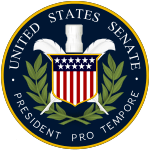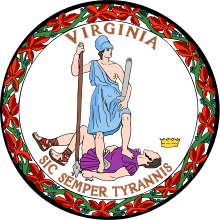Littleton Waller Tazewell
| Littleton Waller Tazewell | |
|---|---|
 | |
| 26th Governor of Virginia | |
|
In office March 31, 1834 – April 30, 1836 | |
| Preceded by | John Floyd |
| Succeeded by | Wyndham Robertson (acting) |
| 29th President pro tempore of the United States Senate | |
|
In office July 9, 1832 – July 16, 1832 | |
| Preceded by | Samuel Smith |
| Succeeded by | Hugh Lawson White |
| United States Senator from Virginia | |
|
In office December 7, 1824 – July 16, 1832 | |
| Preceded by | John Taylor |
| Succeeded by | William C. Rives |
| Member of the U.S. House of Representatives from Virginia's 13th district | |
|
In office November 26, 1800 – March 3, 1801 | |
| Preceded by | John Marshall |
| Succeeded by | John Clopton |
| Member of the Virginia House of Delegates | |
|
In office 1798–1800 | |
| Personal details | |
| Born |
December 17, 1774 Williamsburg, Virginia |
| Died |
May 6, 1860 (aged 85) Norfolk, Virginia, U.S. |
| Political party |
Democratic-Republican Democratic |
| Spouse(s) | Anne Stratton |
| Alma mater | College of William and Mary |
| Profession | Politician, Lawyer |
Littleton Waller Tazewell (December 17, 1774 – May 6, 1860) was a U.S. Representative, U.S. Senator from and the 26th Governor of Virginia.
Biography
Tazewell, son of Henry Tazewell, was born in Williamsburg, Virginia, where his grandfather Benjamin Waller was a lawyer, who taught him Latin.[1] Tazewell was privately tutored by John Wickham; he later graduated from the College of William and Mary at Williamsburg in 1791. He studied law, was admitted to the bar in 1796, and commenced practice in James City County, Virginia. He was a member of the Virginia House of Delegates from 1798 to 1800. Elected to the Sixth United States Congress to fill the vacancy caused by the resignation of John Marshall, he served from November 26, 1800, to March 4, 1801. Tazewell moved to Norfolk, Virginia in 1802. He held public office again in 1804 in the Virginia General Assembly until 1806. Then again served in the Virginia House of Delegates from 1816 to 1817. He was one of the commissioners of claims under the treaty with Spain ceding Florida in 1821.
Tazewell was elected in 1824 to the United States Senate to fill the vacancy caused by the death of John Taylor. Re-elected in 1829, he served from December 7, 1824, to July 16, 1832, when he resigned. While in the Senate, he was President pro tempore of the Senate during the Twenty-second United States Congress and chairman of the Senate Committee on Foreign Relations. His principal published work is Review of the Negotiations between the United States and Great Britain Respecting the Commerce of the Two Countries (1829) New International Encyclopedia. Tazewell received 11 electoral votes for Vice-President in the election of 1840.

Politically, Tazewell was a Jeffersonian Republican, and upon the fissure of that party he associated with the Jacksonian Democrats. Tazewell was elected to the U.S. House in 1800 to complete the term in the Sixth Congress when John Marshall resigned. Tazewell was senator from 1824 to 1832.
Tazewell served as a delegate from Norfolk to the Virginia Constitutional Convention in 1829-1830,[2]
When the Whigs secured majorities in the Virginia Assembly for six years, they first elected the Old Republican as a Whig governor 1834-36, when he resigned a year before the end of his term.[3] Tazewell's governorship was marked by promoting expansion of both the James River canal and the Kanawha Canal. Under his leadership, the Assembly instructed Virginia’s US Senators to support internal improvements, protective tariffs, and a national bank in support of Henry Clay’s American System.[4]
Following his term as Governor of Virginia from 1834 until 1836, Tazewell retired from public life. He died in Norfolk, Virginia, on May 6, 1860. Initially interred on his estate on the Eastern Shore of Virginia, he was re-interred in 1866 at Elmwood Cemetery, Norfolk.
Tazewell, Virginia, Tazewell County, Virginia and Tazewell County, Illinois are named in his honor, and in his father's honor, as are the cities of Tazewell and New Tazewell, Tennessee. A plaque in his honor is found at the corner of Tazewell and Granby streets in Norfolk, near the Tazewell Hotel and Suites, where his two-story house was located. His house, known as the Boush-Tazewell House, was completely dismantled and re-erected in its present location about three miles from its original site around 1902.[5] It was listed on the National Register of Historic Places in 1974.[6]
Tazewell was the maternal grandfather of Littleton Waller Tazewell Bradford (1848–1918), a prominent Virginia politician, and a founder of Pi Kappa Alpha Fraternity.
A building at the College of William and Mary is named in Tazewell's honor.[7]
References
- ↑ Virginia and Virginians, R. A. Brock, University of Virginia Library
- ↑ Heinemann, Ronald L., et.al., "Old Dominion, New Commonwealth: a history of Virginia 1607-2007", 2007, ISBN 978-0-8139-2609-4, p.172.
- ↑ Salmon, Emily J. and Edward D.C. Campbell, Jr., “The Hornbook of Virginia History”, ISBN 0-88490-177-7, 1994, p.109
- ↑ Dabney, Virginius. “Virginia: the New Dominion”, ISBN 978-0-8139-1015-4, 1971 p. 219
- ↑ Virginia Historic Landmarks Commission Staff (January 1974). "National Register of Historic Places Inventory/Nomination: Boush-Tazewell House" (PDF). Virginia Department of Historic Resources.
- ↑ National Park Service (2010-07-09). "National Register Information System". National Register of Historic Places. National Park Service.
- ↑ "William & Mary- Harrison & Page Halls". Retrieved 2 July 2016.
External links
| Wikimedia Commons has media related to Littleton Waller Tazewell. |
- Congressional biography
- Discourse on the Life and Character of the Hon. Littleton Waller Tazewell Hugh Blair Grigsby, Published by J. D. Ghiselin, Norfolk, 1860
- A Guide to the Executive Papers of Governor Littleton W. Tazewell, 1834-1836 at The Library of Virginia
| United States House of Representatives | ||
|---|---|---|
| Preceded by John Marshall |
Member of the U.S. House of Representatives from Virginia's 13th congressional district November 26, 1800 – March 4, 1801 |
Succeeded by John Clopton |
| United States Senate | ||
| Preceded by John Taylor |
U.S. Senator (Class 2) from Virginia December 7, 1824 – July 16, 1832 Served alongside: James Barbour, John Randolph, John Tyler, Jr. |
Succeeded by William C. Rives |
| Political offices | ||
| Preceded by Samuel Smith |
President pro tempore of the United States Senate July 9, 1832 – July 16, 1832 |
Succeeded by Hugh L. White |
| Preceded by John Floyd |
Governor of Virginia March 31, 1834 – April 30, 1836 |
Succeeded by Wyndham Robertson Acting Governor |
| Party political offices | ||
| Preceded by Richard M. Johnson William Smith |
Democratic nominee for Vice President of the United States (Split) 1840 |
Succeeded by George M. Dallas |
| Honorary titles | ||
| Preceded by Benjamin Tappan |
Oldest living U.S. Senator April 20, 1857 – May 6, 1860 |
Succeeded by William Wilkins |


